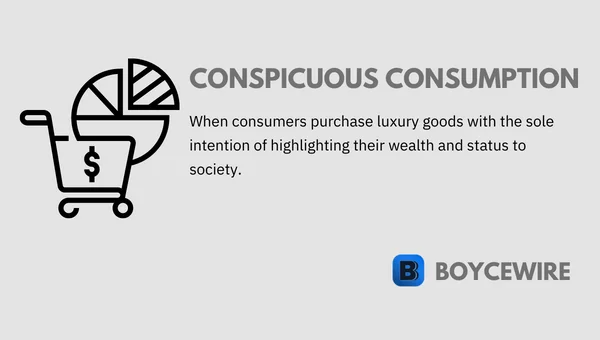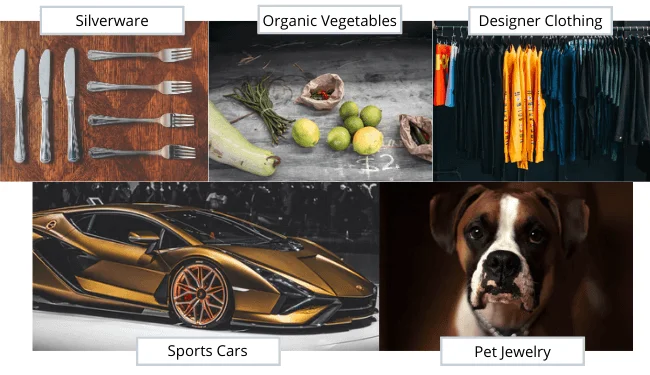Conspicuous Consumption: Definition & Examples

What is Conspicuous Consumption
Conspicuous consumption is where the consumer spends excessive amounts in order to highlight their wealth to society. In other words, they buy expensive items that are not needed but are bought solely to display their wealth and power to the world. Examples might include designer clothing, sports cars, and gold-plated furniture.
The theory of conspicuous consumption was originally coined by American economist, Thorstein Veblen, in his book, “The Theory of the Leisure Class”. He notes that conspicuous consumption has been around for centuries, if not millennia. For instance, if we look at the huge, extravagant expenditures by Kings through Europe and the needless gold and silver-plated armour of noblemen. We find throughout history there was a need to show superiority through a display of wealth.
As conspicuous consumption can be seen throughout history, it is argued that it may be an inherent characteristic within humans. For instance, the need to flaunt wealth can be seen as a sign of establishing self-esteem and self-worth. If you are richer than everyone down your street, you may feel like you are superior. In a way, it reflects the naturally competitive nature of us as humans.
Key Points
- Conspicuous consumption is where consumers purchases goods and services purely to highlight their wealth to others.
- According to Veblen, the main cause of conspicuous consumption is mainly the desire for peer recognition and higher social status.
- Whilst the desire for peer recognition and higher social status are drivers of conspicuous consumption, other factors include social media, consumerism, and economic advancement.
In economics, a lot of the study evolves around rational behaviour. For instance, when prices rise, demand falls. However, economists also need to consider the psychological factor which is purely emotional. In the case of conspicuous consumption, people are driven from the normal ‘rational’ economic model, towards what can be seen as irrational decision making.
The decision to purchase a $50 million painting to sit on the wall can be considered highly irrational by most. It fulfils no basic human need and is an extravagant expenditure that is not needed.
Causes of Conspicuous Consumption
So what truly causes conspicuous consumption? We have briefly touched on the fact that it may be an inherent characteristic in humans, but that is not necessarily the case. Many rich people such as Mark Zuckerberg operate on a very low-key, modest lifestyle – wearing just jeans and a shirt, whilst driving a basic family car worth $30k.
The reality of the situation is that it largely depends on the individual. With that said, the desire for peer recognition and higher social status are key causes of conspicuous consumption – even though it might not apply to everyone. We can look at other factors as variables that exasperate and enhance conspicuous consumption.

1. Capitalism and Consumerism
Capitalism faces a lot of criticisms and at the forefront of these is the apparent rise of consumerism. It is argued that capitalism only enhances the desire for people to acquire more goods and services in an ever-increasing amount. Instead of buying luxury products such as a new Ferrari or the latest Gucci bag, that money would be best served in helping the poor achieve their basic needs.
The argument is that capitalism encourages extravagant spending through advertising and marketing. Governments want consumers to spend as it stimulates the economy and makes them look good. So in a circle of spending, both business and governments want people to spend more.
2. Economic Advancement
Consumers today can afford to spend conspicuously due to the material advancement seen in society. Advances in agriculture and technology have meant that the production of necessities such as food and water have become cheap. That leaves a higher level of disposable income for individuals to pursue other forms of consumption.
3. Human Nature
It must be said that humans have very different world views, so whilst some see conspicuous consumption as a necessity, others don’t. However, there is a tendency for a significant percentage of consumers to engage in conspicuous consumption. This is driven by psychological aspects – mainly the desire for peer recognition and higher social status.
According to Veblen’s original theory, both peer recognition and higher social status were the two main factors contributing to conspicuous consumption. These psychological elements have been present throughout human history – demonstrating them as the key factor over and above the others. In fact, we can look at the other factors as side causes that only exasperate the inherent human nature.
With that said, personalities differ and the need for peer recognition or higher social status is not necessarily inherent in every individual.
4. Social Media
Social media highlights the rich and extravagant lifestyles of others. This might be an all-inclusive holiday to Barbados or a new Lamborghini. Whatever it is, it can lower the viewer’s self-esteem and self-worth. After all, we have a tendency to compare ourselves to others and the rich.
In turn, the active and constant comparison to others plays an important role in conspicuous consumption. More often than not, it creates a drive to compete, or, to use an English-idiom, ‘keep up with the Joneses’. A somewhat vicious cycle is created whereby social media posts encourage others to make lavish expenditures so they can in turn post thereby increasing their social status.
How to Stop Conspicuous Consumption
On an individual level, it is very difficult to stop conspicuous consumption. If peer recognition and a sense of a higher social status is important, it will be difficult to stop conspicuous consumption. However, the first step is to acknowledge that it exists. As a consumer, is it necessary to get the latest iPhone, or is it because it is a status symbol?
Perhaps the new sports car is not because it is a necessity, but because it is a sign of social status. So in order to stop conspicuous consumption, it is first necessary to identify where it exists on an individual basis. Part of that process is really questioning why specific purchases are being made. Is it to impress friends and family, or provide a feeling of self-worth?
Stopping Conspicuous Consumption on a Macro Scale
On a macro scale, we may want to reduce conspicuous consumption to reduce waste and improve the lives of the whole population. One way to do this would be to introduce a progressive consumption tax. So the more expensive the product, the higher tax the consumer would pay.
For example, if someone wants to pay $200,000 for a Ferrari, they may have to pay an additional tax of $100,000. That money could then be used for public goods such as schools. So not only does it discourage conspicuous consumption, but also brings in tax revenue.
Examples of Conspicuous Consumption

Designer Clothes
We can see clothes as a necessity – purely on the basis that it keeps the consumer warm. Now there are a wide variety of styles and quality that come at different prices. For instance, a $50 jacket may last longer than a cheaper $10 version. However, designer brands take this to the next level. For instance, a men’s jacket from Louis Vuitton costs in excess of $1,000.
Jewelry for Pets
Jewelry in general can be considered as conspicuous consumption – after all, it is not a necessity and serves no real tangible purpose. Yet this is taken to a whole new level when owners buy jewelry for their pets. This is almost the ultimate status symbol that says ‘I have so much wealth, I can waste it on jewelry for my pet’.
Organic Vegetables
Organic vegetables are slightly different from the other examples here in the fact that it is very subtle. We may not consider organic vegetables as conspicuous consumption, however, organic vegetables are very expensive. Not many people on low wages can afford them – so in turn, it can not only be seen as a status symbol but also create a sense of moral superiority.
Silverware
When guests come over for lunch or dinner, you may hear the phrase ‘let’s get the fancy silverware out’. So when friends and family come over, they see the expensive cutlery on the table with the food served on fancy plates. The purpose is simple – to create a feeling on enhanced social status and achieve peer recognition.
Sports Cars
Nobody needs a sports car – they are an unnecessarily extravagant expenditure. However, they can be fun to drive. Yet how many rich millionaires can we see in the middle of big cities such as London and New York driving in their Lamborghini’s. They are not being used as sports cars in the city where they cannot even remotely be used for their core purpose. Instead, they are just status symbols of wealth and exuberance.
FAQs
Conspicuous consumption is where individuals purchase goods that do not fulfil an immediate human need, but are purchases that are intended to highlight their social status and obtain peer recognition.
Designer clothes are an example of conspicuous consumption. They are not a necessity and is an exuberant purchase that does little other than highlight the social status of the individual.
Conspicuous consumption is not necessarily bad, but it can be seen as a wasteful use of resources whilst others in the country struggle to make ends mean.
About Paul
Paul Boyce is an economics editor with over 10 years experience in the industry. Currently working as a consultant within the financial services sector, Paul is the CEO and chief editor of BoyceWire. He has written publications for FEE, the Mises Institute, and many others.

Further Reading
 How is Inflation Measured - So now we have looked at what money essentially represents, let us look at how inflation is measured. Inflation is…
How is Inflation Measured - So now we have looked at what money essentially represents, let us look at how inflation is measured. Inflation is…  Circular Flow Model - The circular flow model is a simplified representation of how money, goods, and services flow through the economy between households…
Circular Flow Model - The circular flow model is a simplified representation of how money, goods, and services flow through the economy between households…  Accounting Equation - The accounting equation represents the fundamental relationship between a company's assets, liabilities, and owner's equity.
Accounting Equation - The accounting equation represents the fundamental relationship between a company's assets, liabilities, and owner's equity. 